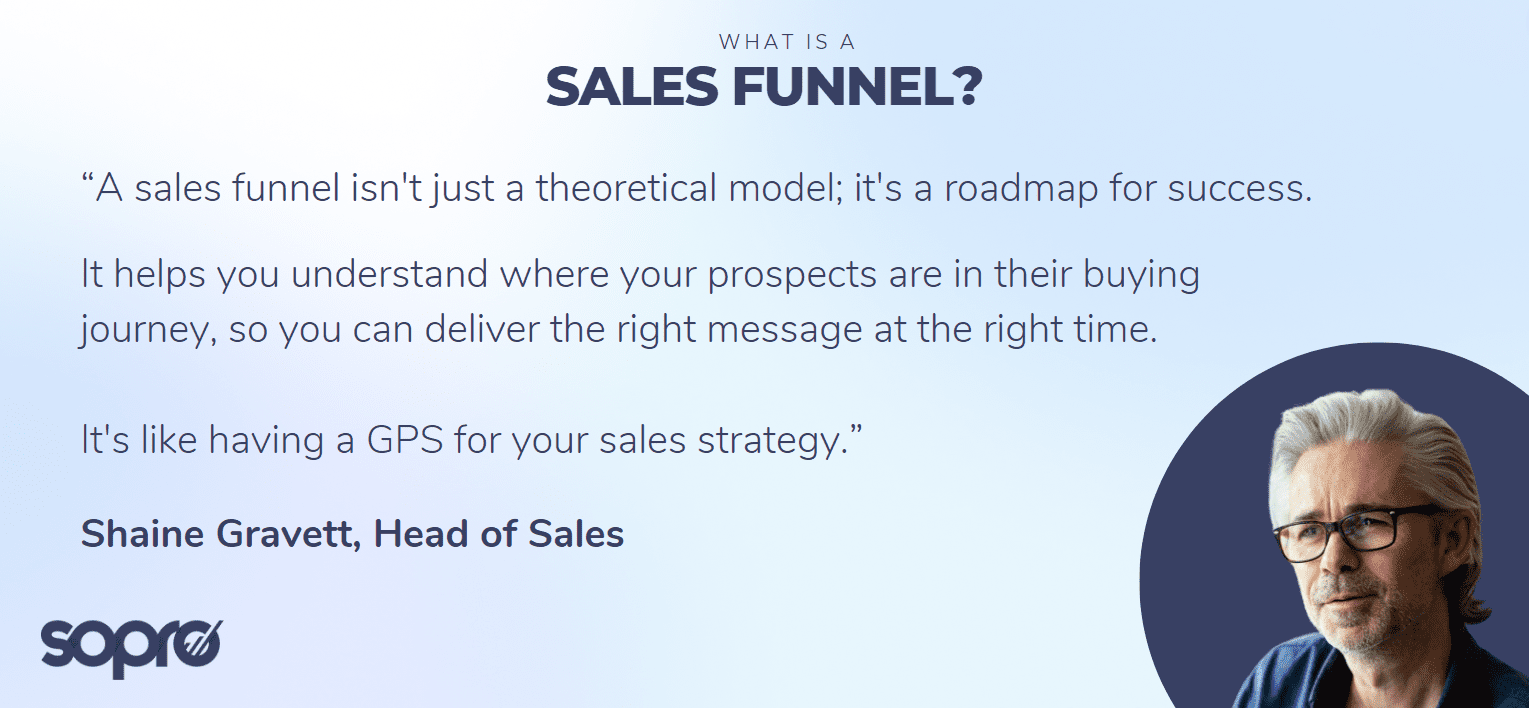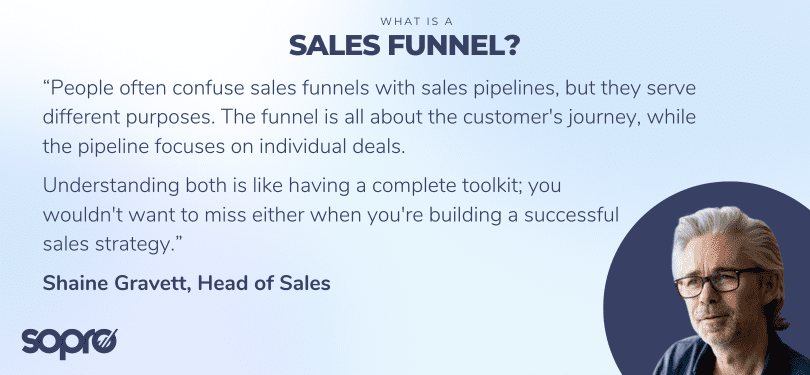What is a sales funnel? A practical guide
In this blog
- What is a sales funnel?
- Why is the sales funnel important?
- What are the five stages of the sales funnel?
- TOFU: Top of the funnel
- MOFU: Middle of the funnel
- BOFU: Bottom of the funnel
- How do you create a sales funnel?
- The power of lead magnets
- Sales funnel vs sales pipeline
- Top tips for sales funnel management

Dive into this practical guide to learn what a sales funnel is, why it’s a game-changer for your business, and how to build one that turns curious clicks into committed customers.
Think about the last great Netflix series you watched.
Maybe you first heard one of your favourite actors talking about their upcoming role on a late-night talk show. Then on your social feed, a teaser clip caught your interest and stopped you mid-scroll.
When the trailer landed, and your work colleagues discussed their excitement, your attention turned to anticipation. So when the series finally launched, you can’t help but be hooked. Suddenly you’re binge-watching through the night to reach the climactic season finale.
The experience is a common one, and not just for bingeabale TV. This is what a well-planned sales funnel works like, with the right content at the right time increasing your likelihood of becoming a customer.
So how can you build a sales funnel for your own business? Why should you? And how do you ensure each stage is pulling people on to the next phase?
What is a sales funnel?
A sales funnel is a model used to represent the journey potential customers go through from the first point of contact with a brand to the ultimate goal of making a purchase. It’s visualised as a funnel to reflect the narrowing process that occurs at each stage as prospects move closer to making a decision, with fewer individuals progressing to the next stage.
The sales funnel typically comprises various stages. Although different models have different stages, they all represent the journey from becoming aware of a brand to being a customer. At each stage, different marketing strategies and tactics are employed to nurture, educate, and encourage prospects towards making a buying decision.

You may also hear the terms marketing funnel or purchase funnel. Sometimes they are presented slightly differently, or you’ll hear that they are from the buyer’s side or seller’s side. Really, they amount to the same thing, so long as you keep both yourself and your customers in mind when working on it.
Why is the sales funnel important?
It reflects the customer journey
The sales funnel is essentially a mirror, reflecting the customer’s journey from that initial curious click to the celebratory moment of purchase and beyond.
It’s all about nurturing a budding relationship at every touchpoint, ensuring a smooth transition from one stage to the next.
But the customer journey isn’t merely a voyage of discovery for the customers, but a treasure trove of data and insights for sales and marketing teams keen to finetune their strategies.
You can optimise the sales journey
A sales funnel can help bring a sense of order to the often chaotic process of acquiring and retaining customers.
But this isn’t just about bringing some zen to your sales team. By mapping the different pathways your prospects travel, and where they get lost along the way, you can make your sales process more effective.
Each stage of the sales funnel should be tailored to the needs of your customers, and help move them onto the next stage, ultimately securing a sale. Pinpoint the areas that require more attention or a sprinkle of creativity to enhance sales performance.
Align sales and marketing
Understanding the sales funnel is a key part of aligning sales and marketing efforts.
If both teams work on understanding and optimising the funnel, it can foster a collaborative spirit instead of a competitive one. After all, the teams ultimately share a common goal – driving more sales.
By having a clear understanding of the sales funnel, the teams can work together to identify problems, produce better processes and collateral, and tailor strategies to resonate with the customers at every stage.
Conversion Rate Optimisation (CRO)
The sales funnel is a veritable playground for CRO enthusiasts. While you might think exclusively of website AB tests, CRO opportunities can be found in many places on your customer journey, from emails and webpages to proposals and pitch decks.
By analysing the behaviour of potential customers within the funnel, tweaks and adjustments can be made to enhance conversion rates. It’s about rolling up the sleeves and diving into the data to unearth opportunities for nudging the customers closer to the ‘buy now’ button.
Map content to funnel stages
The beauty of a well-oiled sales funnel lies in its ability to guide potential customers through their buying journey seamlessly.
A big part of this guidance is delivered through content. Mapping content to each stage of the funnel avoids throwing information into the digital abyss, and helps you deliver the right message, to the right person, at the right time.
What are the five stages of the sales funnel?
Although models of the sales funnel vary, we’re going to use a five-stage version which includes awareness, interest, desire, action, and loyalty.
As we’ve seen, sales and marketing content should be aligned with these different stages of the funnel. For the five funnel stages, we have three content categories: top of the funnel, middle of the funnel, and bottom of the funnel.
TOFU: Top of the funnel
In the TOFU stage, the main aim is to spark interest in potential customers and make them aware of your brand, products and solutions.
It’s essential to identify your audience, understand their challenges, and tailor your content so it offers solutions to their pain points. Your content should be engaging and easily digestible.
Think short videos on social media, educational blog posts, big content marketing pieces, guest appearances on established podcasts, and online advertising. At this stage, you can get creative, but be careful not to stray from your goals in the hunt for vanity metrics.
This stage isn’t just about casting a wide net; it’s about attracting the right kind of attention from individuals who will find value in what you offer. It’s also not about securing a sale – be helpful, not pushy. By doing so, you’re laying the foundation for deeper engagement as people move down the sales funnel.
The goal is to create awareness, educate, and build trust with a broad audience.
Stage 1: Awareness
The awareness stage is the first point of contact between potential customers and your brand.
It’s crucial to create a positive impression, with the aim of encouraging further engagement. It’s a long-term game though: 95% of your audience won’t be “in market” when they discover you, but with good awareness, they will be able to recall your brand when the time comes.
Leverage social media and content marketing to highlight your brand and provide value. Identifying and addressing your audience’s pain points during this stage is key to getting the right people to discover your brand..
Stage 2: Interest (and consideration)
After igniting awareness, the interest stage aims to nurture curiosity about your offerings.
Here, prospects delve a bit deeper into the solutions you provide, using content like eBooks, webinars, or newsletters that continue to educate and engage potential customers.
In many versions of the funnel, this phase may be called consideration (or it is added as an additional stage). Having become aware of your potential solution, the prospect has an interest and would consider a purchase, but not before gaining a greater understanding.
The goal is to maintain interest, encourage further research, and provide the details that will move them to the next stage.
MOFU: Middle of the funnel
MOFU is where the relationship deepens. The content in this stage should be more product-centric, showcasing how your solutions stand out.
Utilising channels like email marketing, targeted social media campaigns, and webinars, with content types such as case studies, product demonstrations, and customer testimonials can be effective.
The goal is to nurture the relationship and build desire for your products or services.
Stage 3: Desire (and evaluation)
The Desire stage is about fuelling the interest of potential customers, and nudging them closer to making a decision.
But your brand is unlikely to be the only option they have come across, so this stage also includes evaluation. The prospect is researching and evaluating multiple options, to ensure they get the decision right.
Research by Harvard Business Review shows that emotional concerns play a large part in B2B buying decisions:
A fear of failure often nags at buyers who spend large amounts of money and make decisions that may affect revenues or many employees.
Showcase the value and benefits of your product or service, illustrating how it addresses their needs or solves their problems. Utilising testimonials and customer reviews plays a pivotal role in building trust and reassuring the buyer they are not making a mistake.
On our site, for example, we have an ROI calculator to help people understand the potential return, (anonymised) campaign results are published live, and our awards, client success stories, and review scores are found across the site.
BOFU: Bottom of the funnel
In the BOFU stage, the content should be focused on conversion and retention.
Utilise channels like targeted email campaigns and retargeting ads, with content types such as product webinars, free trials, and customer success stories. The goal is to prompt action and build loyalty.
Stage 4: Action
The Action stage is all about encouraging potential customers to take a decisive step, be it making a purchase or signing up for a service.
Crafting compelling calls to action and offering deals or incentives can be effective strategies.
The sales team plays a crucial role in providing personalised guidance and assurance to prompt action. For any B2B sales pipeline that includes a demo before purchase, sales enablement content will play a crucial role in the purchase decision. From buyer’s guides to proposal decks, this content plays a crucial role at the pointy end of the funnel.
Stage 5: Loyalty
So, you’ve made a sale and have a brand new customer on your books. Job done, right?
Actually, after a successful action, comes the Loyalty stage. This part focuses on ensuring customer satisfaction and building a lasting relationship.
Implement strategies like follow-up emails, satisfaction surveys, and loyalty programs to encourage repeat business and referrals.
Providing excellent customer service and continuing to offer value through helpful content and support are key to nurturing loyalty.
How do you create a sales funnel?
Understanding your target audience
The cornerstone of building a sales funnel is a deep understanding of your B2B target market.
Dive into their needs, preferences, and behaviours. Know what keeps them up at night, and how your product or service can be the hero in their story. It’s about getting into the nitty-gritty of who your audience is, what they want, and how they behave.
Build your funnel with content
Ensuring you have content for each stage of the sales funnel is crucial. Conduct a content audit to identify any gaps, by mapping your existing content to each stage of the funnel.
Incorporate the sales funnel stage in your content calendar to ensure a balanced distribution of content across all stages.
Tailor the narrative at each stage to guide your customers closer to making a purchase, ensuring a smooth transition from one stage to the next.

How content can upgrade your lead generation
Why you need content as part of your lead generation strategy, how to create high-quality content
Read the blogTools and platforms
With the blueprint of your sales funnel in place, it’s time to bring in the builders – tools and platforms that help create and manage your sales funnel.
Platforms like Salesforce are stellar for managing customer relationships and analysing funnel performance. Tools like Google Analytics are great for tracking customer behaviour through the funnel, while email marketing platforms like HubSpot are handy for nurturing leads through content.
When it comes to bottom-of-the-funnel actions, Sopro’s multi-channel prospecting service enables you to contact your entire B2B audience directly and meet them where they are. With coordinated outreach across channels, corporate gifts to help sweeten the deal, and your prospects’ website actions revealed in the portal,
Measuring success
Measuring the success of your sales funnel is crucial to understanding how well it’s performing.
Luckily, there’s no shortage of sales pipeline metrics to help you; conversion rates at each stage, customer lifetime value, and return on investment are key indicators.
They provide a clear picture of where you’re shining and where there’s room for a little more polish.
The power of lead magnets
Definition and importance
Lead magnets are those irresistible nibbles of value that tease and lure your prospects into the sales funnel, exchanging their contact information for your insightful goodies. They are crucial because they act as the gateway into your funnel, capturing the interest of potential customers and coaxing them into engaging with your brand.
Lead magnet examples
- Reports and whitepapers: Offering insightful ebooks or whitepapers on industry-specific topics not only showcases your expertise but provides genuine value to your audience.
- Webinars and online courses: Hosting a webinar or offering courses can help educate your audience on topics that matter to them, allowing them a taste of what your brand can offer.
- Free trials and demos: Letting your prospects experience your product or service firsthand can lower the resistance and help them see the value themselves.
- Discounts and special offers: Everyone loves a good deal! Providing a discount or a special offer in exchange for their contact information can be a great incentive.
- Checklists and templates: Simplifying a complex process with a ready-to-use template or a handy checklist can save your audience time and effort, and they’ll thank you for it.
These lead magnets are instrumental in moving potential customers down the sales funnel, gently transitioning them from the awareness to the consideration phase, and eventually towards making a buying decision.
Sales funnel vs sales pipeline
Sales pipeline definition
The sales pipeline zeroes in on individual sales deals, tracking the journey of prospects from lead to customer across distinct stages of the sales process.
While the pipeline is deal-centric, the funnel is customer-centric, each offering a unique perspective on the sales journey.
Funnel and pipeline integration
Marrying the sales funnel and sales pipeline can foster enhanced sales management. This marriage ensures a smooth handover from marketing to sales, making sure the right leads are nurtured and prospects continue to be engaged post-conversion.

For a richer understanding and a detailed comparison, hop over to our comprehensive guide on sales funnels vs sales pipelines.
Top tips for sales funnel management
Managing a sales funnel isn’t a task you can tick off your list and forget about. It’s a continuous cycle of monitoring, analysing, tweaking, creating and training. Let’s delve into the core elements of sales funnel management that ensure your funnel doesn’t just exist, but thrives.
Monitoring and analysis
To maintain a high-performing funnel, you should monitor the journey of prospects from the top to the bottom. Analyse why something happens, not just how much it does. Why are prospects getting stuck in a particular stage? Why did a promising lead go cold?
Looking at the conversion rates of each stage, the time spent in each stage, and the volume of leads at each stage can provide a health check on your funnel if you can, find out why leads went cold. This process helps to identify bottlenecks and identify opportunities that could accelerate the sales journey.
Optimisation
Every stage of the sales funnel has its unique needs and challenges. Optimisation is about tailoring strategies to each stage to nudge prospects closer to the buying decision.
Regular A/B testing can be a goldmine in discovering what resonates with your audience and what doesn’t. It’s about the iterative process of refining and enhancing the sales funnel to improve conversion rates.
Competitor analysis can be good for ideas, but the best source for optimisations is getting the sales and marketing teams working well together: get marketing on the sales calls, have regular meetings, and make it easy for sales to request new collateral.
Training and Development
A well-trained sales team is your ace in the hole. Ensuring your team is well-versed in not only your offerings but also the dynamics of the sales funnel is crucial.
Training programs that focus on understanding customer behaviours, navigating the sales funnel, and employing effective sales strategies are invaluable. Development sessions that hone the skills of your sales team in handling objections, nurturing relationships, and closing deals can significantly impact the effectiveness of your sales funnel management.
Read our guide on setting up a lead disposition process for information on further optimising your sales funnel.
Technology Integration
In this digital age, leveraging technology is non-negotiable for efficient sales funnel management. Customer Relationship Management (CRM) systems are paramount in tracking and managing interactions with prospects and customers.
Having a robust lead generation machine which provides clear data on what is and isn’t working is also key. Sopro’s multichannel prospecting service is built on eight years of experience, the latest tech and the freshest data to engage the right people with the right message. So you can sit back and watch those high-quality leads roll in.
But if you want to dive into the data and optimise your sales funnel, your live campaign results are always available in our interactive portal. Every email, every prospect, every campaign. Discover what’s working, which segments respond best, and the messaging that makes people want to know more.




Share